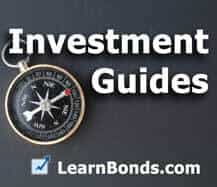
If you are looking at a 10 year corporate bond which is yielding 5% for example, and at the same time the 10 Year treasury bond is yielding 2%, then the credit spread is 300 basis points (3%).
Treasuries are the Foundation of Bond Market Credit Spreads
Because US Treasuries are free of default risk, other bonds are compared to treasuries in order to get an idea of their credit risk. When this article was written GE Capital Bonds with a 5 year maturity, were yielding 1.80%. The equivalent US Treasury was yielding .61% so the credit spread was 119 basis points (1.19%).
The bonds of JCPenney (which is not in great financial shape) on the other hand, were yielding 8.3%. As you can see the credit spread for JCPenney Bonds at 769 basis points is much “wider” than the spread for Exxon Mobile bonds at 119 basis points (a much “tighter” or “narrow” spread than JCPenny).
If you visited the trading floor of a major investment bank you would likely hear a bond trader say something like “Ford Sold 1.5 Billion 5 year bonds this week at T + 238”. This means the yield that Ford is paying on these bonds is the yield on the 5 year treasury + 238 basis points (2.38%). In other words bond traders look at the yield of a bond in terms of where it is trading vs. treasuries. This gives them more context on how risky the market views Ford bonds than simply looking at the yield of the bond in isolation.
Charts of historical credit spreads
In addition to looking at credit spreads for individual bonds, investment account owners will also look at the credit spread of different categories of bonds. For example, by comparing a group of corporate bonds (like investment grade corporate bonds) vs. treasuries, you get a picture of where the average investment grade bond credit spread currently stands.
Luckily there are indexes available which make this comparison for you, so you do not have to calculate it yourself. Two of the most popular are the:
- BofA Merrill Lynch Corporate Master Option Adjusted Spread – represents the credit spread of the corporate bond market as a whole.
- BofA Merrill Lynch High Yield Master II Option Adjusted Spread – Represents the credit spread of the high yield bond market as a whole.
You can find charts of both of these indexes as well as others here.
Interest rates change over time and so do credit spreads
Interest rate changes for different types of bonds do not normally occur in unison. For example, when there is a lot of uncertainty in the market investors tend to park their money in super safe US Treasuries, causing the yield of US treasuries to drop. The yields on high yield bonds on the other hand, tend to rise in times of uncertainty as investors shun risky assets. So even though treasury yields are falling in this example, the credit spread is getting wider.
By looking at how the credit spread for a category of bonds is changing, you can get an idea of how “cheap” (wide credit spread) or “expensive” (tight credit spread) the market for those bonds is related to historical credit spreads. Investors will also look at credit spreads for clues as to where the bond and other markets may be headed. You can read more about how credit spreads change over time here.
Credit Spreads do not represent only credit risk
There is a common misconception that looking at credit spreads gives you a complete picture of the credit risk of one bond compared to another. This is inaccurate, because there are other factors which combine with credit risk to make up the “spread premium” that other types of bonds have over treasuries.
For example, bonds with favorable tax treatment such as municipal bonds can actually trade at a yield which is below US Treasuries. This is not because the market considers them less risky than US Treasuries, but because many municipal bonds are considered almost as safe as treasuries AND they have a big tax advantage over treasuries. Similarly many corporate bonds are illiquid, meaning it can be difficult to sell the bond once you have bought it because there is not an active market for the bond. Investors will therefore require a higher yield than would otherwise be the case for this bond, increasing its credit spread.
Here are a list of some of the other factors that can be included in the credit spread for different types of bonds in addition to credit risk:
- The bond’s duration.
- Embedded options such as callability
- Event risk (natural disasters, regulatory changes etc)
- Liquidity
For the definition and meaning of other bond related words visit the Learn Bond Glossary where we give explanation of many more terms.
This lesson is part of our Free Guide to the Basics of Investing in Bonds. Continue to the next lesson here.
Trusted & Regulated Stock & CFD Brokers
What we like
- 0% Fees on Stocks
- 5000+ Stocks, ETFs and other Markets
- Accepts Paypal Deposits
Min Deposit
$200
Charge per Trade
Zero Commission on real stocks
64 traders signed up today
Visit Now67% of retail investor accounts lose money when trading CFDs with this provider. You should consider whether you can afford to take the high risk of losing your money.
Available Assets
- Total Number of Stocks & Shares5000+
- US Stocks
- German Stocks
- UK Stocks
- European
- ETF Stocks
- IPO
- Funds
- Bonds
- Options
- Futures
- CFDs
- Crypto
Charge per Trade
- FTSE 100 Zero Commission
- NASDAQ Zero Commission
- DAX Zero Commission
- Facebook Zero Commission
- Alphabet Zero Commission
- Tesla Zero Commission
- Apple Zero Commission
- Microsoft Zero Commission
Deposit Method
- Wire Transfer
- Credit Cards
- Bank Account
- Paypall
- Skrill
- Neteller
What we like
- Sign up today and get $5 free
- Fractals Available
- Paypal Available
Min Deposit
$0
Charge per Trade
$1 to $9 PCM
Visit Now
Investing in financial markets carries risk, you have the potential to lose your total investment.
Available Assets
- Total Number of Shares999
- US Stocks
- German Stocks
- UK Stocks
- European Stocks
- EFTs
- IPOs
- Funds
- Bonds
- Options
- Futures
- CFDs
- Crypto
Charge per Trade
- FTSE 100 $1 - $9 per month
- NASDAQ $1 - $9 per month
- DAX $1 - $9 per month
- Facebook $1 - $9 per month
- Alphabet $1 - $9 per month
- Telsa $1 - $9 per month
- Apple $1 - $9 per month
- Microsoft $1 - $9 per month
Deposit Method
- Wire Transfer
- Credit Cards
- Bank Account



